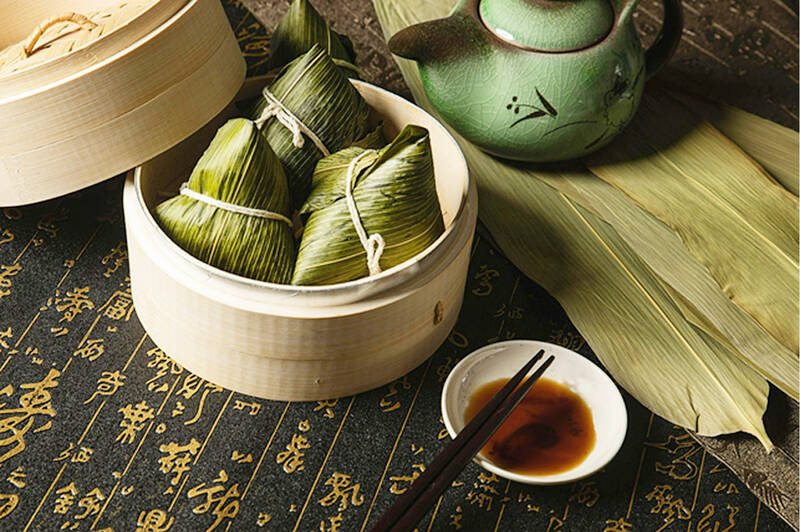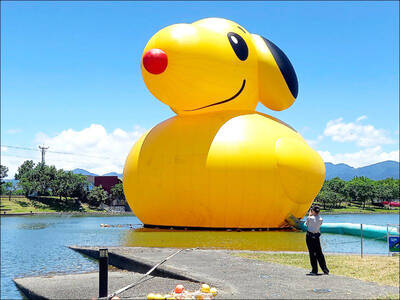Around the time of the Dragon Boat Festival in June, the streets of Taiwan are filled with the delightful aroma of zongzi, a traditional snack made of sticky rice wrapped in leaves. The leaves are folded into a cone and then filled with sticky rice and other ingredients such as braised pork belly, peanuts and salted duck egg yolks. The filled leaves are then tightly tied with kitchen twine and ready for cooking.
每到六月端午時節,街頭巷尾就會飄出粽子的香氣。粽子是將糯米包進粽葉的傳統美食,先將粽葉折成圓錐狀塞入糯米,以及紅燒肉、花生、鹹鴨蛋黃等配料,用棉線綁緊後即可烹煮。
Dragon Boat Festival (n. phr.) 端午節

Photo: Pexels l 圖片:Pexels
aroma (n.) 香氣,香味
As a zongzi is cooked, the leaves release an herbal aroma that is a feature of this beloved dish. The cooking method of zongzi can differ greatly between regions. People in northern Taiwan usually steam zongzi, in which its rice and ingredients are stir-fried before being steamed, resulting in a more flavorful taste. People in southern Taiwan prefer to boil them. The boiled version has a gooey and sticky texture and a stronger herbal aroma due to the longer boiling time.
粽煮過之後粽葉會發出香氣,是粽子的一大特色。台灣南北煮粽子的方式不同,北部人大多用蒸的,米飯和配料蒸之前會先炒出香氣,南部人則偏好用水煮的粽子,煮的時間久,米粒更軟黏,粽葉香氣更濃。
herbal (adj.) 藥草的,香草的
gooey (adj.) 軟黏的
In addition to regional variations in the cooking methods used for zongzi, the leaves used to wrap them also vary by region. Three commonly used materials to wrap zongzi are giant timber bamboo leaves, the husks of makinoi bamboo and shell ginger leaves. In the south, where zongzi are usually boiled, the giant timber bamboo leaves they are wrapped in help them withstand the boiling process. In the north, husks of makinoi bamboo are more often used as a wrapper, which has a distinctive light brown color as they are the outer shell of bamboo.
除了烹煮方式,粽葉也是因地而異。台灣常用的粽葉有麻竹葉、桂竹葉和月桃葉,麻竹葉適合需長時間水煮的南部粽,桂竹葉則常用來包北部粽。桂竹葉是竹籜(筍殼),故為淺棕色。
Shell ginger can be seen everywhere in the countryside of Taiwan. The Hakka people, in particular, appreciate and use its leaves as a wrapper for zongzi because it imparts an aroma that comes from the plant to the rice. Its leaves can not only be used as a zongzi wrapper, the Paiwan people, a group of indigenous people in Taiwan, have traditionally used them for weaving handicrafts like baskets.
月桃於台灣田野間隨處可見。客家人特別愛用月桃葉包粽子,會讓粽子帶有月桃香氣。月桃葉不止能作粽葉,用途廣泛,排灣族的傳統編織也會用月桃葉編成籃子等手工藝品。
countryside (n,) 鄉村,農村地區
Hakka (n.) 強迫(某人)客家人
indigenous people (n. phr.) 原住民
The tradition of eating zongzi during Dragon Boat Festival can be dated back to the Warring States period (c. 475–221 BCE). It is celebrated on the fifth day of the fifth lunar month to commemorate Qu Yuan (c. 340–278 BCE), a renowned poet and loyal statesman of the Chu state. His honesty and outspoken nature often put him at odds with the ruler of Chu, so he was banished from the state for 18 years. During his banishment, Qu Yuan remained devoted to his state, but watched with despair as it continued to decline.
端午節吃粽子的習俗歷史悠久,最早可追溯至戰國時期(約公元前475–221年)。每年農曆五月五日的端午節,是為了紀念楚國愛國詩人屈原(約公元前340–278 年),他因直言不諱得罪楚王,遭流放18 年。即便流落他鄉,仍心繫故國,卻只能眼睜睜看著楚國走向衰亡。
statesman (n.)(受人尊敬的)政治家
banish (v.) 放逐,驅除出境
Qu Yuan was overwhelmed with grief and drowned himself in the Miluo River on the day that is now commemorated as the Dragon Boat Festival. To honor his integrity, people wanted to keep the fish in the river away from his body. They rowed boats to scare away fish and threw rice wrapped in leaves into the river for them to eat instead of his body. Over time, this memorial has evolved into the popular celebration of the Dragon Boat Festival, which includes zongzi eating and dragon boat racing and has been observed for centuries.
他悲痛至極,於農曆五月初五投汨羅江自盡。人們感念他的情操,於是在河中划船驅趕魚群,並用竹葉包米飯扔進河裡,希望河中的魚不要去吃屈原的身體。千年之後,這項紀念活動已轉變成端午節吃粽子和賽龍舟的習俗。
drown (v.) 淹死,溺死
observe (v.) 過,慶祝,紀念(節日、事件)
文章由書林出版公司提供:
www.bookman.com.tw

A: The news says comic superstar Snoopy’s birthday is coming soon on Aug. 10. B: So he’s a Leo, and his birthday will fall on this Sunday. A: Cartoonist Charles Schulz created the comic strip Peanuts, featuring Snoopy, in 1950. And this year marks the character’s 75th anniversary. B: No wonder there are some big celebrations in Japan, Hong Kong and elsewhere. How about Taiwan? A: The “How Do You Do, Snoopy?” exhibition is taking place in Taipei. Let’s go to Shin Kong Mitsukoshi Department Store’s A11 branch to see the show. A: 新聞說,卡通巨星史努比的生日是8月10日耶。 B: 原來史努比是獅子座,本週日就是他的生日。 A: 漫畫家查爾斯舒茲1950年在《花生》漫畫創造了該角色,今年正好歡慶75週年! B:

When you think of the Netherlands, images of tulips, windmills, and iconic wooden shoes — known as “Dutch clogs” — may come to mind. These traditional shoes are rich in cultural significance. For centuries, Dutch clogs have been admired for their sturdy design and impressive craftsmanship, making them a fascinating symbol of Dutch heritage. Dutch clogs date back to the Middle Ages. During that time, farmers and laborers needed durable shoes to cope with the region’s damp and unpredictable climate and topography. Crafted from solid wood, such as willow or poplar, clogs offered outstanding protection. Their firm structure kept

Bilingual Story is a fictionalized account. 雙語故事部分內容純屬虛構。 “One DA-BEI... WU LONG... NAI?” Yujing smiled as the foreigner struggled to order. He looked like an embarrassed puppy. She repeated the order in Chinese, then English: “Oolong milk tea, large size. Half sweet, no ice?” she said gently. He beamed — the kind of full-face, sunshine smile that Latinos are famous for. “Yes! That! You are... lo maximo… the best!” After he left, Lily nudged her. “Nice save. You’re getting the hang of it.” Yujing had taken this summer job at the bubble tea shop to build confidence and get work

A: Apart from the “How Do You Do, Snoopy?” exhibition, the Penghu International Fireworks Festival displayed some Snoopy-themed balloon installation art. B: The Yilan International Children’s Folklore & Folkgame Festival also displayed a giant rubber “Snoopy Duck.” A: And Starbucks, Kura Sushi and 7-Eleven are all selling Snoopy-themed products. B: Starlux Airlines even launched new Snoopy-themed flights recently. Isn’t that cool? A: Taiwanese love Snoopy so much. Happy 75th birthday, Snoopy. A: 除了《How Do You Do, Snoopy?花生漫畫75週年特展》,澎湖海上花火節展出了史努比氣球裝置藝術。 B: 而宜蘭國際童玩藝術節,則展出了巨型「史努比鴨」。 A: 星巴克、藏壽司、7-Eleven也推出了史努比聯名商品。 B: 星宇航空今年更推出全新「Snoopy主題航班」,很酷吧? A: 台灣人好愛史努比啊,75歲生日快樂!